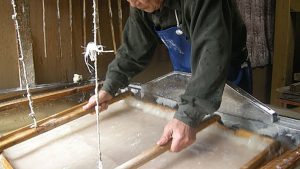Active Washi-Making places
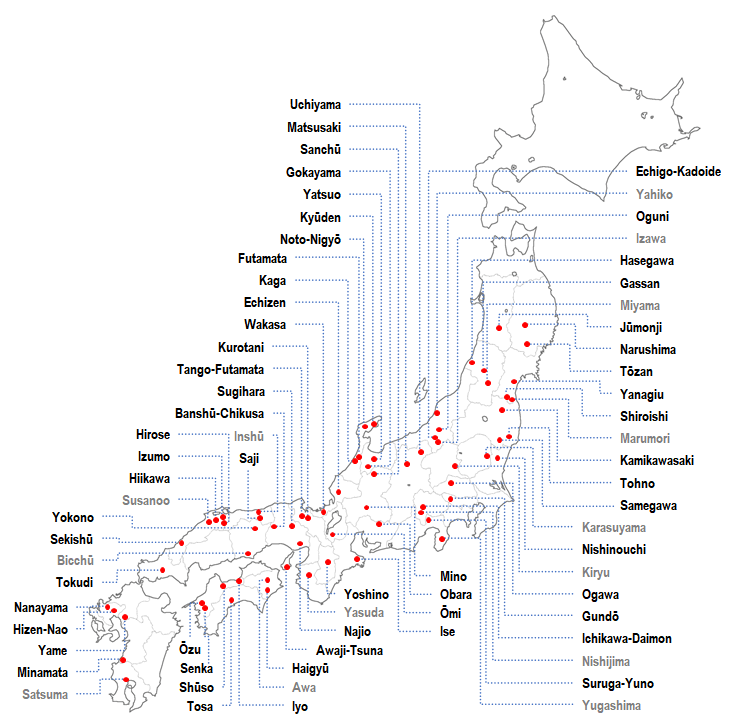
* The boldly lettered districts are introduced in this site.
| Districts (Code) | Excerpt | Material | Workshops | ||||||||||||||||||||
|---|---|---|---|---|---|---|---|---|---|---|---|---|---|---|---|---|---|---|---|---|---|---|---|
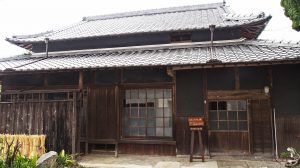 Awajitsuna Gami (AT) | Awaji-island (淡路島), according to Japan myth, this is the first island of Japan. It has more than 1000 years of papermaking history. After the big bridge was built in 1998, it became very convenient accessing from the big city Kobe and Osaka. However, in the deep mountain area, there still are silent farmer's villages. In such a sleeping village, Mr Okuda Yoshiharu is running a small workshop. He uses only local material around his house, half-wild Kozo and the other plants. So, his production volume is quite small. His working style is not sophisticated, just based on the traditional way, carefully and faithfully. The paper is "idyllic" atmosphere like himself. | Kozo |
| ||||||||||||||||||||
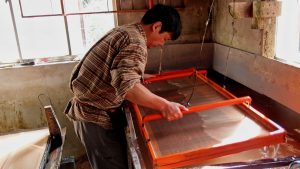 | Mimasaka (美作), current a part of Okayama prefecture, has been known as a paper-making district since the 8th century. The name was described on the Shōsō-in(正倉院) document. At present, only the Ueda family in the Kami-Yokono village inherits the tradition. They use only Mitsumata, cultivated locally. The paper is used for the lining of Gold-Leaf, thin and strong, light yellow-brown coloured. That is one of the Washi which represents the Japanese culture. | Mitsumata |
| ||||||||||||||||||||
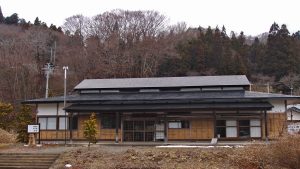 Narushima Gami (NR) | Narushima is the northern end place of Washi making in Japan. Although there are more than 1000 years of history, it was almost disappeared recently. To keep the tradition, the local government built the Washi making facility and invited the Aoki family who had long local Washi making history. They have no big production, but the paper using local Kozo with Noriutsugi from the mountains is purely beautiful paper based on their tradition. | Kozo |
| ||||||||||||||||||||
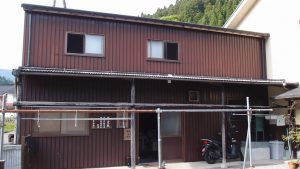 Banshū-Chikusa Washi (BC) | Mr Yoshitome Shin'ichi learnt paper-making under Mr Baba of Najio and Mr Tange of Bicchū. After that, he looked for the best place for his target paper. He aimed to make the paper which can be used for conservation of national treasures. His workshop is located very far from the cities, just surrounded mountains. Although there were paper-making houses in history, it was not existing until he came. At his ideal place, he finally succeeded to make high-quality paper, as he imagined. Production volume is not big, but trustable quality papers are made here. | Kozo Mitsumata Gampi |
| ||||||||||||||||||||
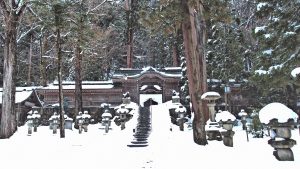 Echizen Washi (EZ) | At this present time, Echizen is one of the biggest Washi district in Japan. According to the myth legend in the times of the Emperor Keitai (継体天皇: early 6th century), a beautiful woman appeared from the upstream of Okamoto River, then she taught how to make papers to the villagers. The village located in the mountain, therefore the place was not good for rice farming. Washi making became effective income for the poor villagers. Villagers worshipped her and call her “Kawakami Gozen (川上御前)”, enshrined her in “Okamoto-Jinja (岡太神社)”. The main building of Okamoto-Jinja (1843) is the listed “National Important Cultural Property”, it is wooden complicated work, always well maintained by villager's appreciation to her. As the indubitable record, Echizen was recorded of five paper making country on the Shosoin document in AD737. The first nationwide banknote was made by them in 1875. Through history, Echizen has influenced the other washi district, and it is still going on. | Kozo Mitsumata Gampi |
| ||||||||||||||||||||
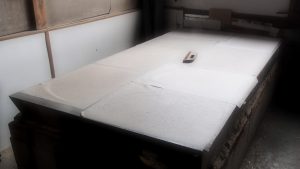 Futamata Washi (FT) | Kanazawa, the capital of Kaga, was the big castle city of the Lord clan Maeda. There were high and wide demands for papers since the end of the 16C. Futamata is located just behind Kanazawa centre over a mountain. The village was certified as the official paper-making place in 1596. After that, they had been making various type of paper for Kanazawa market, ex: gold-leaf beating paper, Hosho (official document paper), painting paper and so on. The tradition is surely inherited by 2 workshops. | Kozo |
| ||||||||||||||||||||
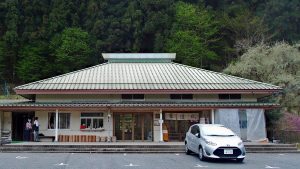 Gundō Shi (GD) | The Gundō Washi history started just after the big war in 1615 (The siege of Osaka in Summer = The end of Toyotomi clan) by the fugitive warriors. Because of the location was nearby Edo (Tokyo), their washi business had been prospered through the 18-19C. Every valley villages produced Washi widely in this area. The technical and material points of view, it is guessed that they were closely linked with Ogawa Washi. In the modern period, the last workshop closed in 1963. After that, in 1987, the local government built the "Gundō-shi House" to remain the washi making history and technique. They use local wild Kozo, very rare species like Hime-Kozo (Kozo original species) and Tsuru-Kozo (Vine Kozo). It can be similar to the original Washi feeling. | Kozo |
| ||||||||||||||||||||
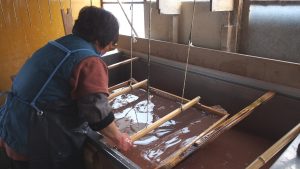 Gokayama Washi (GK) | The Gokayama traditional houses and country life in snow country is listed on the UNESCO World Heritage Sites. Here in winter, the village is covered by heavy snow, therefore indoor work for winter season was encouraged through the history. In the Edo Period (1603-1868), Washi industry had been the major income source for the local government “Kaga-han”. They cultivate Kozo locally and keep making traditional paper. And also, there is a big public facility of Washi for tourists. This paper is called “Ecchu Washi” in conjunction with Yatsuo (八尾) Washi in same Toyama prefecture. | Kozo |
| ||||||||||||||||||||
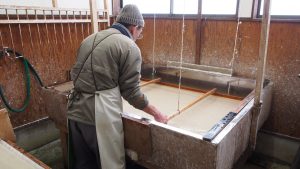 Gassan Shi (GS) | The mountain "Gassan (月山)", ski season starts from May, because it is too heavy snow. In such a severe place, Mr Miura Kazuyuki makes beautiful papers alone silently. The workshop name "Sampo" means "stroll around". He learnt Washi-making at Ogawa training centre. After that, he moved to this place, where Washi-making was almost disappearing. He learnt this place's Washi additionally from the local old artisan. His paper is loved by many Japanese traditional painters. And he also makes beautiful Benihana(紅花) flower petals paper, which is the representative flower of the prefecture. | Kozo |
| ||||||||||||||||||||
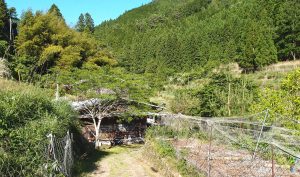 Haigyū Shi (HG) | Shikoku(四国) is a steep mountain range island. In the east part of the island, there is a tiny village surrounded by mountains, where is not easily accessible. An artisan, who looks like a mountain hermit, makes very creative papers. Because it is not a very convenient place, he uses natural and wild materials, which are available only around his workshop. His paper is the most unique in Washi world. It is good for interior decoration. Every paper is one and only. Therefore, the sample is not provided. Please ask us the detail of it. | Kozo |
| ||||||||||||||||||||
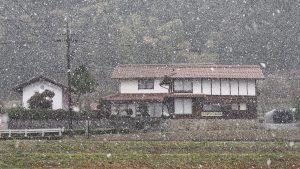 Hiikawa Washi (HK) | Izumo(出雲) is the place of Japanese myth. The deep mountain area is well known for the myth of the Eight-Heads Dragon (Yamata-no-Orochi) and the ancient iron-making for the sword. Washi-making history is also very old, one of the oldest Washi production districts. The name “Hiikawa” was named independently by the current master Mr Itani Shinji's father, using the name of the river which is streaming nearby. He makes various papers using Kozo/Mitsumata/Gampi, is good at the mix-material and dyed paper which is quite unique and attractive, rather than standard single-material paper. Hiikawa Washi has a high reputation among Japanese Folk crafts world. | Kozo Mitsumata Gampi |
| ||||||||||||||||||||
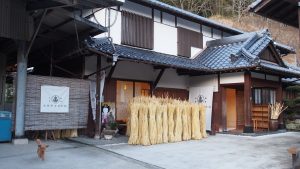 Hizen-Nao Washi (HN) | Nao village is surrounded by mountains. There were only small spaces for rice making. To improve their economy, in 1690, Mr Noutomi Yusuke, who was the village leader, asked Buddhism monk Nichigen, who were making Washi in Chikugo, to teach for them Washi making. The mountains around Nao was full of wild Kaji trees. The fibre of Kaji is longer than Kozo's. Their paper won the reputation as a very strong paper. The paper was used for the durability required purpose, such as umbrella, lantern, raincoat. Nowadays, the Taniguchi family is continuously making various creative papers using the local Kaji. | Kozo (Kaji) |
| ||||||||||||||||||||
 Hirose Washi (HS) | The history, the local government ordered making the banknote paper to Hirose valley people in 1668. In this modern time, there were no workshops in this area, in 1973, Mr Nagashima Isao came back to his home and started washi making, after 12 years working in the workshop (Izumo) of Mr Abe Eishiro who was the living national treasure. He devised equipment to meet high requirement for his demanding customers, like water softener and drying panel. Recently, a young successor joined the workshop. We hope this valley's washi history will remain for the future. | Kozo Mitsumata Gampi Straw |
| ||||||||||||||||||||
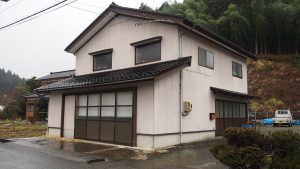 Hasegawa Washi (HW) | Mr Hasegawa Satoshi learnt Washi making under the legendary artisan Mr Saito Hiroshi in Futamata and Mr Furuta Kozo in Mino. He inherits the genuine traditional technique from the artisans, especially good at very thin Kozo paper. He had worked in Mino for some decades, in 2017, he moved back to his home town Tsuruoka of Yamagata prefecture, opened his own workshop. The paper made from high-quality Nasu Kozo is highly admired among the conservators. | Kozo (Nasu) |
| ||||||||||||||||||||
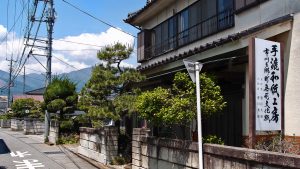 Ichikawadaimon Shi (ID) | The Genji clan introduced Washi making to Ichikawa in early 12C, after that, every Lords supported their paper through the centuries. The paper was used for the usage of temples in the early time, then adopted as the local government official document paper in Edo (1600-1986) era. Mr Toyokawa keeps the tradition and also tries to make paper with local fruits' fibre and flavour. Yamanashi prefecture is the kingdom of grapes in Japan. That is the action of local product creation. | Kozo |
| ||||||||||||||||||||
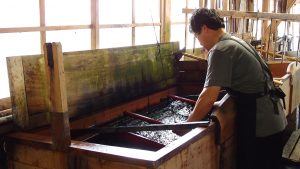 Izumo-Mingei Shi (IM) | Mr Abe Eishirou(安部榮四郎) is one of the legends of modern Washi history. He led “Japanese folk-art movement(日本民藝運動)” together with Mr Bernard Leach and Mr Yanagi Souestu(柳宗悦), also investigated and researched the historical papers, including Shōsō-in treasures. He was certified as the first living national treasure of Washi in 1968 together with Mr Iwano Ichibei (8th) of Echizen. Many artisans were learnt and influenced by him. His grandsons keep running the workshop. They make various papers skillfully using Kozo/Mitsumata/Gampi, for instance, “Izumo Cloud paper” and “Gampi paper” which Mr Bernard Leach was impressed at. Their papers remain old atmosphere very well. | Kozo Mitsumata Gampi |
| ||||||||||||||||||||
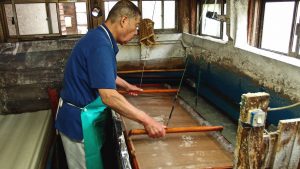 Iyo Gami (IY) | Iyo Washi history is not very old, roughly said since the 1750s. They had produced Kozo paper same to other districts in the beginning period. In late 19c, the "Improved Mitsumata Paper (改良紙: Kairyo-shi) " was invented in this district. The paper became very popular immediately as the calligraphy paper (書道半紙: Shodo Hanshi) widely in Japan. Today, in fact, Kawanoe, centre of Iyo washi, is a modern machinery paper industry town, the biggest production in Japan. On the other hand, only two handmade Washi makers are remaining. But they are still keeping their history of Kawanoe paper. | Kozo Mitsumata Gampi |
| ||||||||||||||||||||
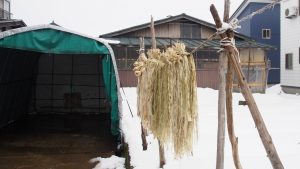 Jūmonji Gami (JU) | Jūmonji is the northern end place of Washi making in Japan together with Narushima. People have been making rustic papers for local usage, ex: paper cloth, harvest sac, and so on. Mr Sasaki Kiyoo is a vegetable and fruits farmer from spring until autumn. In winter, under the snow-covered village, he makes papers the same as his grandfather did. Recently, the 10+ villagers built a team to support his washi-making. We hope that Kozo cultivating, Material treatment, Washi making can be passed to the next generations. | Kozo |
| ||||||||||||||||||||
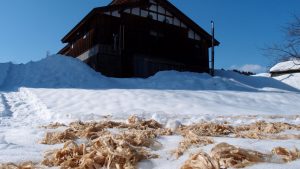 Echigo-Kadoide Washi (KD) | Although there are many Washi making districts, this is the definitely heaviest snow place. Sometimes it snows a couple of meters in one night. Because there is few sun-shine through winter, therefore they keep the wet paper stacking under the snow until April, quite unique method "Kangure". They start drying the paper under the spring sun. The paper is surely like the original old Washi. Mr Kobayashi Yasuo has a credo, "How we can revive the wildlife in the paper for the 30th century". He is definitely one of the representative of Washi artisans. | Kozo |
| ||||||||||||||||||||
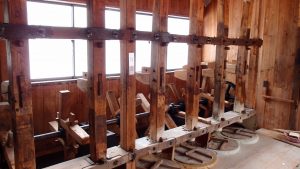 Kaga-Gampi Shi (KG) | Kanazawa, the capital city of Kaga, has been full of gorgeous craft culture since 17C. The Lord clan Maeda supported various artisans to make beautiful crafts. The gold-leaf is an indispensable material for these crafts. In neighbouring to Kanazawa, Nakajima area's Washi making was stood on the demand for gold-leaf making in Kanazawa. Kato Washi is the prestigious family of Washi making established in 1783. Recently, the artisans of gold-leaf are using glassine paper instead of traditional paper. So, Kato Washi has been making another type of paper like a certificate of merit. We hope they can have a chance to make their original paper again. | Gampi |
| ||||||||||||||||||||
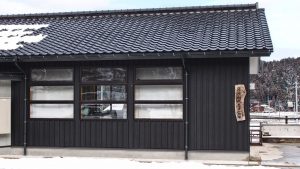 Kyūden Washi (KN) | At the north end of Noto peninsula, there is a small silent village, named Kyūden. The villagers had made Washi since 350 years ago. Because of the modern industrial wave, it was disappeared early 19C. In 1988, the local elementary school re-started Washi making as a part of history learning. Although the school was closed in 2002, the villagers established a common working group to maintain Washi making, for never disappearing again. Even it is a very small production, the paper is used for local usages, like a certificate of merit. | Kozo |
| ||||||||||||||||||||
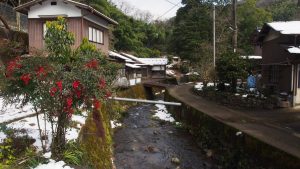 Kurotani Washi (KT) | In the north of Kyoto prefecture, there is a silent valley village, named Kurotani. 800 years ago, Heike clan lost the war against Genji clan. The fugitive warriors hid in this valley, then started Washi making quietly. Their paper awarded fame as strong paper among the big demand for Kyoto. In 1996, they established a cooperative association to maintain the history and technique and are tackling nurturing successors. Recently, the valley got big damage by Typhoon, but they are powerfully revived by villager's big effort. | Kozo |
| ||||||||||||||||||||
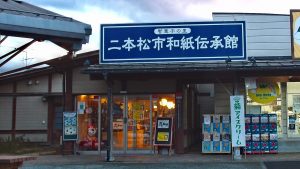 Kamikawasaki Washi (KW) | Mayumi-gami, which was made from Mayumi Tree (Euonymus hamiltonianus), was the popular paper 1000 years ago in Heian-era. Murasaki Shikibu (紫式部 = author of the "Tale of Genji") and Sei Shonagon (清少納言 = author of "The Pillow Book"), both mentioned the paper named as "Mutsu-shi" or "Michinoku-gami" in their stories. It is said that that paper might be made in Kamikawasaki. Although there is not existing Mayumi-gami anymore, this district has a long history of paper-making. Recently, although paper-making has been quickly disappearing in this area, the people are tackling to maintain the history to the future. | Kozo |
| ||||||||||||||||||||
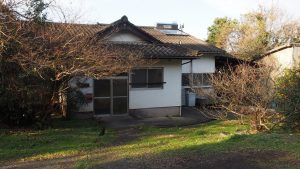 Minamata Gami (MM) | Mr Kanesashi Jumpei has an international viewpoint. He has visited Amazon, Samarqand (Uzbekistan) and Borneo (Indonesia) to not only research the history and also teaching papermaking to the people. Eventually, through the experience, he understood how natural paper should be. He is tackling to make various natural material paper with his wife who is a dyer. Ecology and Tradition are surely combined on his paper. | Kozo Mitsumata Gampi Bamboo Straw .... |
| ||||||||||||||||||||
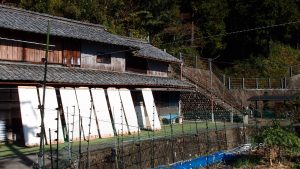 Mino Washi (MN) | Mino is one of the oldest and biggest Washi production district, was listed on the UNESCO world heritage in 2014. The one of the oldest remaining paper in Japan is Mino paper, which is a family register and tax paid record dated in AD702. There were many Washi production sites in the Itadori River (板取川) basin widely, more than 5,000 houses for Washi in the golden age in the 19th century. At present, the centre of production is Warabi area. Mino Washi has been the standard of Shoji (障子: papered sliding window) Paper. Most of the other districts had been following their paper. The paper, which is made with genuine traditional method, distinguishes it from others and is called “Hon-Mino shi (本美濃紙)”. It is used for important traditional construction like the national treasures. | Kozo Mitsumata Gampi |
| ||||||||||||||||||||
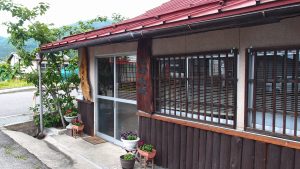 Matsusaki Washi (MS) | Matsusaki washi has a long history. When the Nishina Shinmei Shrine was built in 1042, the servants started to make the required paper for shrine work. Their skill was also introduced to the local farmers. Because of the heavy snow, outside work was impossible in the wintertime. They made papers in the house through the snow season. Koshihara family succeeded in showing the rich nature of Nagano on paper. The paper, which contains local leaves and flowers, has a warm atmosphere, can be used for various folk-crafts. These are one and only paper, the sample is not available. please ask us for the details. | Kozo |
| ||||||||||||||||||||
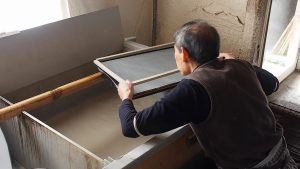 Najio Washi (NJ) | Najio is located near to big city Kobe, just behind the Rokko Mountains (六甲山). The representative paper is made from local material, Gampi and Rokko mountain clay. It has won fame with strong and unti-worm. According to the legend, a man, named Higashiyama Yaemon, learnt Washi making in Echizen, and brought it to this place, maybe late 15th or mid 16th century. After that, the paper was accomplished original development using local clay from the local Mountains. In the history, many famous painting was drawn on this paper, especially in Kyoto. In the past, they were called “Najio thousand workshops (Najio Senken = 名塩千軒)”, shown the most of the villagers were involved in Washi making. Nowadays, although residential development has been invading this place, two workshops are continuously making traditional Gampi paper. | Gampi |
| ||||||||||||||||||||
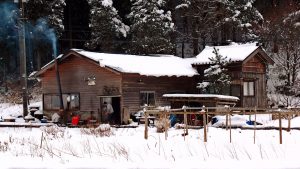 Noto-Nigyō Washi (NN) | Noto-Nigyō Washi is quite unique, definitely one and only. Mr Tohmi Shusaku invented the Yashu-shi, stuffing wild plants in 1949. It contains Flower, Straw, Cedar Bark, Seaweed, Shell and even field Soil. That is truly the aggregation of Noto peninsula wildlife. That Cedar Bark paper was used for the book-cover by Mr Bernard Leach, who was the leader of “Japanese folk-art movement(日本民藝運動)”. The Shusaku's grand-son Mr Tohmi Kazuyuki keeps developing how to make the beautiful paper as his grandfather did. | Kozo Gampi Wild Plants |
| ||||||||||||||||||||
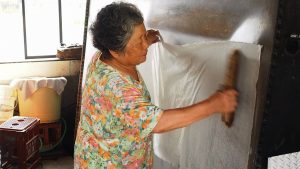 Nishinouchi Washi (NU) | There are more than 1000 years of Washi history in Hitachi (current Ibaraki pref.), Nishinouchi was one of the main production sites. Mito government, one of the three major part of the national government, encouraged Kozo farming and Washi production in the late 17th century for their government project "Great History of Japan (Dai-Nihonshi)". Through the project, the paper won stable reputations as strong and waterproof. It became very popular in Edo (Tokyo) using for account book and election paper. At the peak era of production, there were 1,663 workshops in the early 18 century. Since long, this place local Kozo, “Nasu-Kozo(那須楮)”, is well-known as the best quality material, so used in the other paper making site. In 1977, Nishinouchi paper was listed to “the intangible cultural assets who should take measures such as the record making”. At present two workshop remains. | Kozo |
| ||||||||||||||||||||
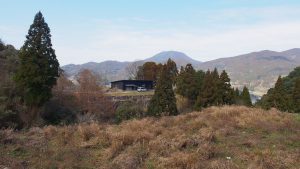 Nanayama Washi (NY) | A young couple Maeda Takaharu and Chiharu opened their workshop near her home village Nanayama in 2007, after 4 years learning under Mr Ebuchi Eikan of Tosa. The technical and material point of view, their Washi can be defined as a kind of Tosa Washi. The paper is very modern and sophisticated, but the making is surely based on the traditional way. Their fresh sensitiveness is appearing on the paper. They are one of the hopes of the Washi industry for the future. | Kozo |
| ||||||||||||||||||||
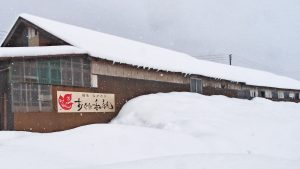 Oguni Washi (OG) | Oguni is heavy snowfall place. In history, people had to stay at home through winter. Therefore, work in-house, Washi making became popular among villagers. Bleaching Kozo material and storing wet paper is the uniqueness of this snow country. The original Oguni paper size is small 39x29cm, which was suitable for their in-house tiny workplace. Mr Imai Hiroaki is one of the leaders of the Washi industry. He is tackling not only making genuine Washi but also cultivating Kozo on a large scale and take on the leading role of various organizations. | Kozo |
| ||||||||||||||||||||
 Ōmi-Gampi Shi (OM) | Ōmi is located just next to Kyoto. The Gorgeous aristocratic culture of Kyoto required elegant paper, not like business purpose in Osaka and government document in Edo (Tokyo). This place's Washi making was grown for usage in Kyoto. The paper using Gampi and natural dye is good for Kana brush calligraphy, especially for ladies. In the modern period, the Naruko paper has been also used for conservation and restoration of various historical treasure. | Gampi |
| ||||||||||||||||||||
 Ogawa Washi (OW) | The Musashi country, current Saitama prefecture, has long paper making history since the 7th century. Although there were many villages for Washi production, at this moment the area of Ogawa and Higashi-Chichibu are remains. In the 17th century, they import the new method from the Hosokawa village of Kishu (current Wakayama Prefecture). The paper, named Hosokawa-shi, became a big deal to meet the huge demand from Edo(Tokyo) city. There is a proverb from that era, "Pikkari Senryo", means "a sunny day makes a million dollars". It indicates their business was extremely big. The Hosokawa-shi was listed on the UNESCO Intangible Culture Heritage in 2014. They are training young artisans to retrieve their former prosperity. | Kozo |
| ||||||||||||||||||||
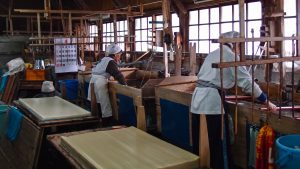 Ozu Washi (OZ) | Ōzu is one of the oldest Washi making place. In the early 17C, they imported technique from Tosa and Echizen, soon after, their paper got the reputation of top quality in Japan wide market. In the 19C, they tackled improving for the Mitsumata paper, they got another high reputation and big market share, especially in the calligraphy paper market. In this way, they have progressive spirit and high skill to make various papers. Tenjin Sanshi is one of the biggest Handmade Washi factories. With their experience and facility, they can meet any requirement of Washi. | Kozo Mitsumata Gampi |
| ||||||||||||||||||||
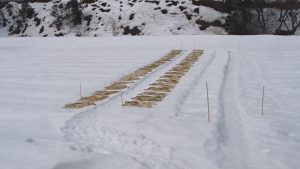 Sanchū Shi (SC) | The name Sanchū means “in the mountain”, here is definitely surrounded by mountains. In the winter season, there is heavy snow. So, the people have been utilizing snow for Washi making. The raw Kozo fibre becomes whiter and softer after laid down on the snow in a few days. This is just traditional, but the best way for Washi fibre. Although it is tough and inefficiency work, The all of the four workshops cultivate Kozo and keep this traditional way. | Kozo |
| ||||||||||||||||||||
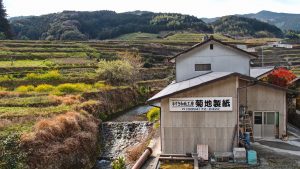 Senka Shi (SE) | Four hundred years ago, Mr Hyodo Tarouemon invented the double-layered paper, and named “Senka-shi(泉貨紙)”. That strong paper became a very popular Washi for Japan-wide. It is recognized with the paper name, not district name. The screen mat is separated into two parts (see photo#2). They lay over two sheets just after scooping material. The paper is quite strong, suitable especially for woodcut painting. And good for paper-clothes making as well. | Kozo |
| ||||||||||||||||||||
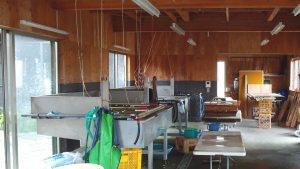 Shūso Shi (SH) | In the 1830s, Mr Tanaka Sahei trained Washi making method in Tosa and brought it back to the village. Generally, Washi production place is located in deep mountains. However, this place is placed in Shūso plains. Because they can use the rich underground water from Shikoku mountains. The Dan-shi (檀紙), which is a unique and beautiful crinkled paper, like corduroy surface, is usually used for the ceremony envelope. Hand-made Danshi is really rare nowadays. Shūso is one of the biggest Dashi producing place. | Kozo |
| ||||||||||||||||||||
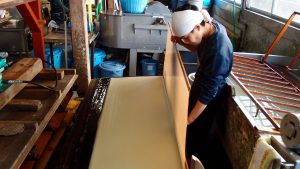 Sekishū Washi (SK) | The Sekishū Washi was the first Washi listed the UNESCO Intangible Culture Heritage in 2009. At present, four workshops inherit their traditional. They cultivate Kozo locally. The Sekishū-Kozo, mainly Aoso (青楮=Green Kozo), is recognized as very high-quality material. Its fibre is thin and tough. The paper is unique because it uses mid-bark of Kozo, which exists between the outer bark and bast fibres, which contains hemicellulose. Therefore, the colour is naturally yellowish at first. This paper can endure long term storage, becoming whiter and stronger as the years pass. The "Sekishū Han-shi (Ban-shi)" is one of the most popular paper for brush calligraphy use. But of course, it would be an excellent paper for any purpose. This district is also positive for international work, especially with Bhutan since 1986. Sending trainers and accepting trainees made a good relationship with them. | Kozo Mitsumata Gampi |
| ||||||||||||||||||||
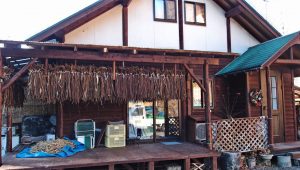 Samegawa Washi (SM) | The people had been making Washi widely in the upstream of Samegawa river since roughly 300 years ago. Recently, the workshops were disappeared. Mr Saisu Kanichi moved in this area to realize natural-life, after his retirement of a government job. He learnt Washi making from local old retired Washi artisans and took over all equipment. He makes unique papers with his own cultivated Kozo and fruits fibre, ex. Apple and Cherry, which is quite idyllic. | Kozo |
| ||||||||||||||||||||
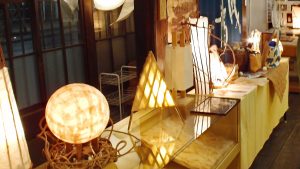 Shiroishi Washi (SR) | Shiroishi Washi was the part of Japan important historical moment. It was used for the Surrender document of WW2 between Japan and the USA. There is a couple of hundred years of history. Especially a legendary artisan, Mr.Endo Tadao’s paper was used for various important official occasions and the Paper cloth at Todaiji Temple ceremony. Although Tadao passed away in 1997, his wife continued Washi making up to recently. Because she became very aged, so the town people built the team to inherit for Washi making. The paper using single unique Kozo species (a kind of Kaji) is soft and white. It is used for Paper Clothes and Embossed paper. The effort of the town people is really respectable. Shiroishi Washi is powerfully reviving now. | Kozo (Torafu) |
| ||||||||||||||||||||
 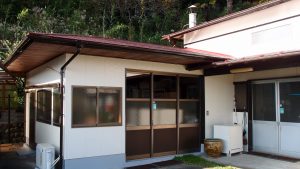 Suruga-Yuno Gami (SY) | Mr Naito Tsuneo learnt Washi-making from some of the master artisans widely in Japan. After that learning season, he built his own workshop at the foot of Mt.Fuji in 1976. At that beautiful place, he started making the mix fibre paper. Generally, Washi is made from single material, but he is a magician for blending Kozo/Mitsumata/Gampi materials. Although the paper itself is quite newly, his making method is surely based on traditional. He makes papers based on the particular severe requirement by professional users. Many big fans of him are existing all over the world. | Kozo Mitsumata Gampi |
| ||||||||||||||||||||
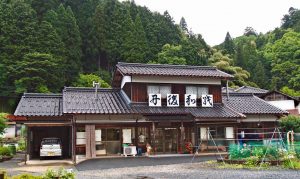 Tango-Futamata Washi (TF) | Tango, the north part of Kyoto, was one of the oldest paper making districts. A part of it, Futamata village passed the history more than 1,000 years always with the brother shrine of Ise, which is the most important shrine in Shinto. There are all the required factors for good paper here, ex: Cool Climate, Rich Soil, Clear Water. Papermaking became the major business of Futamata, supported by stable usage demand for the shrine, and also demand in the capital city Kyoto. Based on the local history and tradition, The Tanaka family is continuously making high-quality paper for the high-level requirement. | Kozo Mitsumata Gampi |
| ||||||||||||||||||||
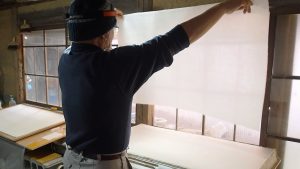 Tokudi Washi (TK) | Around 1200, a Buddhist monk "Chougen" taught the Washi making method to the people. Through the 17-19C, the Lord protect and support them as the three major productions of Choshu-han. Although they are a small Washi making district at present, they were the biggest production place 100 years ago in Japan, more than 4,000 houses were engaged in Washi production. Before the modern tissue paper appeared, their "Shiraho-gami (白保紙)" was the best selling paper in Japan, especially among ladies. The history was almost disappearing recently. In 2014, Mr Chijimatsu Tomoyuki returned to his home to maintain the history fo his family. He learnt Washi making from his father who was the famous master artisan and Mr Rogier Uitenboogaart of Tosa. | Kozo Mitsumata Gampi |
| ||||||||||||||||||||
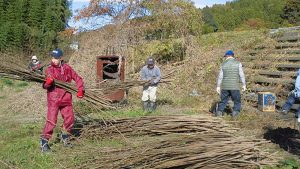 Tohno Shi (TN) | According to the local history record, 106 houses, around 40% of villagers, were making Washi in 1743. In 1887, the number increased to almost 400 houses. However, same as other cases, Washi making house had decreased rapidly, the last artisan retired in 2010. The Iwaki city government recruited a young couple as the successor in 2018. Plus a young lady from New Zealand joined the workshop in 2019. They are making the traditional Tohno Washi with local volunteer staffs. | Kozo |
| ||||||||||||||||||||
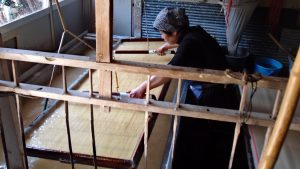 Tosa Washi (TS) | Tosa is the old name of Kochi prefecture. The Tosa paper was listed on the record book “Engi-shiki (延喜式)” at the very early stage, has more than 1300 years in the history. Since the Edo period (1603-1868) to present, Tosa has been one of the three biggest production sites together with Mino and Echizen. There is rich water and sunshine. So, here is quite prominent as not only paper production but also Kozo farming. Ino-cho, along the clear stream Niyodo river, is the centre of production, and also some artisans are making paper in other areas in Kochi prefecture. Papermaking is the local pride for Tosa people. There are many facilities, Museum, Experiencing place and Technical Research Centre. | Kozo Mitsumata Gampi |
| ||||||||||||||||||||
| Tōzan Washi making started at the end of the 12th century by order of the Fujiwara clan who had strong govern in this area. The word “Tōzan” means “East Mountain”, there is the same name (Higashi-Yama) place also in Kyoto. They wanted to build a city like Kyoto here, so they used the same name for this area. After they lost the war against Genji in 1189, Washi making had been continued through the centuries by villagers. They cultivate Kozo and Mitsumata for their paper. This north part of Japan is very cold, eventually, the quality of their material is quite high. To remain this historic culture, some of the young villagers started training and recently got official guarantee by master artisans. We hope they will continue to make Washi in future. | Kozo Mitsumata |
| |||||||||||||||||||||
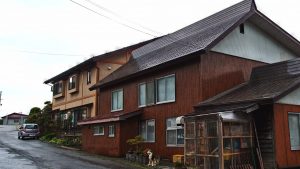 Uchiyama Gami (UC) | Uchiyama was one of the biggest Shoji paper production areas 100 years ago. Today, only Abe family keeps making hand-made Shoji paper in this district. The Washi making technique was imported from Mino in AD1661, and they have kept improving the paper as the snow country paper maker for the white paper. This place is located in a heavy snow area, there was a part of the Winter Olympic game in 1998. The genuine Shoji paper is sold as the rolled form. Therefore, the genuine Shoji door should become masonry with the seam like the photo#2. | Kozo |
| ||||||||||||||||||||
 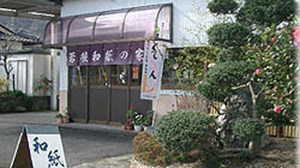 Wakasa Washi (WK) | Washi making in Wakasa is very old, maybe in the 8th century. According to the history book (901-922) of this country, people paid papers as tax. In Edo-period 17-19C, the Washi business became big, supported by the Lord. Obama has been the centre of Washi production in this district. At present, only one workshop keeps making Washi. Because the location is close to Kyoto, so the paper has been used for Kyoto Yuzen print since long. Yuzen requires clear colour boundary. This paper realizes it without sizing. | Kozo |
| ||||||||||||||||||||
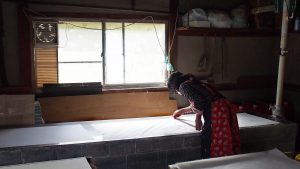 Yame Tesuki Washi (YM) | Yame Washi is the biggest Washi production district in Kyushu. In the golden age, there were 1,800 houses for Washi making. At present, 6 workshops are still active. They are using unique Higo Kozo, which has very long fibre more than 4cm. (Higo is the name of the neighbour prefecture Kumamoto's old name) So, the paper is very strong as the fibre interlocking tightly. The range of product is very wide for Art, Conservation, Interior and so on. | Kozo (Higo) |
| ||||||||||||||||||||
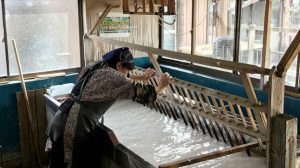 Yanagiu Washi (YN) | In Yanagiu, there are 400 years of paper-making history in this district since the famous Lord "Date Masamune" era. The Sato family has maintained 10 generations of paper-making at the same place. Ms Sato Fumie decided to retire at the age of 90 in 2019. Her daughter Keiko took over the workshop to continue the history. The paper is used for various local unique folk-art, like "Dharuma doll", paper cloth, paper muffler and so on. | Kozo |
| ||||||||||||||||||||
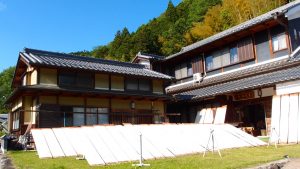 Yoshino Washi (YO) | Yoshino is nearby located in the south-east of the ancient capital city, Nara. According to the legend, the Prince Ōama (Emperor Tenmu, ?-AD686) taught the technique of papermaking to villagers. Although “Kuzu(国栖)” area of Yoshino was papermaking village since very early. The neighbouring village “Uda(宇陀)” traders started selling their paper to widely Japan in 17C, then their paper was called “Uda-Gami”. At present, Uda-gami and Misu-gami, which is made in this village, is the most important paper for conservation and restoration for the old pictures/paints including the national treasures. Yoshino area is also well-known with the cedar-timber industry. Recently, the cedarwood bark paper was invented, is it used as interior wallpaper. There are five workshops. All of them are the highest technique holders. Here can be one of the heartlands of Washi making. | Kozo |
| ||||||||||||||||||||
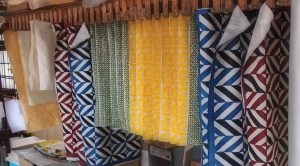 Yatsuo Washi (YT) | There were almost 500 paper-makers alongside Ida River in Yatsuo town 100 years ago. This province “Ecchu” was famous as medicine production. The Ecchu-washi was grown with medicine business, like wrapping paper and bags for the powder and tablets. After WW2, the living national treasure of cloth-dyeing artisan, Mr Serizawa Keisuke (芹澤銈介), started dyeing on papers with Keijusha, instead of clothes, because of its lack. Today, they are making more than 250 beautiful patterned papers. This is one of the representatives of the Japanese folk-art. | Kozo (Folk-Art) |
|

